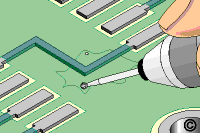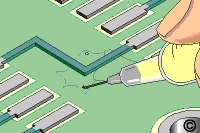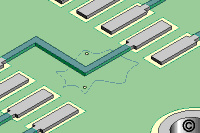No. 3.1
Delamination/Blister Repair, Injection Method
OUTLINE
This method is used to repair mechanical or thermal blisters or delaminations in circuit board laminated base materials. The blister is sealed by injecting a low
viscosity epoxy into the blister/delamination void.
CAUTION
This method can only be used when the laminate base material has separated
sufficiently to allow the epoxy to flow throughout the void area.
TOOLS & MATERIALS
Adhesive Dispenser
Ball Mills
Base Board Repair Kit
Cleaner
Epoxy
Heat Lamp
Micro-Drill System
Oven
Scraper
Vacuum Source, Optional
Wipes
PROCEDURE
- Clean the area.
- Drill into delamination blister with the Micro-Drill and ball mill. Drill in
an area clear of circuitry or components. Drill at least two holes opposite each
other around the perimeter of the delamination. (See Figure 1). Brush away all
loose material.
CAUTION
Be careful not to drill too deep exposing internal circuits or planes.
CAUTION
Abrasion operations can generate electrostatic charges
- Bake the circuit board to remove any entrapped moisture. Do not allow the circuit
board to cool prior to injecting the epoxy.
CAUTION
Some components may be sensitive to high temperature.
- Mix the epoxy. See manufacturers instructions on how to mix epoxy without
bubbles.
CAUTION
Exercise care to prevent bubbles in the epoxy mixture.
- Pour the epoxy into the epoxy cartridge.
- Inject the epoxy into one of the holes in the delamination. (See Figure 2).
The heat retained in the circuit board will improve the flow characteristics of the
epoxy and will draw the epoxy into the void area filling it completely.
- If the void does not fill completely, the following procedures may be used:
- Apply light local pressure on the board surface starting at the fill hole,
slowly proceeding to the vent hole.
- Apply vacuum to the vent hole to draw the epoxy through the void
- Cure the epoxy per Procedure 2.7 Epoxy Mixing and Handling
- Scrape away any excess epoxy using a knife or scraper.
NOTE
If needed, apply additional thin coating to seal any scrapped areas
EVALUATION
- Visual examination for texture and color match.
- Electrical tests to conductors around the repaired area as applicable.
|
|
|
Solutions Across the Board
TM
|
|
|
|
Product Class: R
Skill Level: Advanced
Conformance Level: High
Revision: D
Revision Date: Jul 7, 2000
Repair Service Charge

Delamination

Figure 1: Drill into the delamination blister using a ball mill and a Micro-Drill.

Figure 2: Inject epoxy into the delamination blister.

Figure 3: Completed repair.

Figure 4: Micro-Drill
System.
|
Tricks of the Trade
This procedure is more difficult than it appears. We recommend a
low viscosity Pre-packaged Epoxy to
allow for proper penetration. A quality built Micro-Drill is essential for drilling the
small injection holes. Use the smallest size Ball
Mill, .019" diameter to drill the holes.
|
|
|
